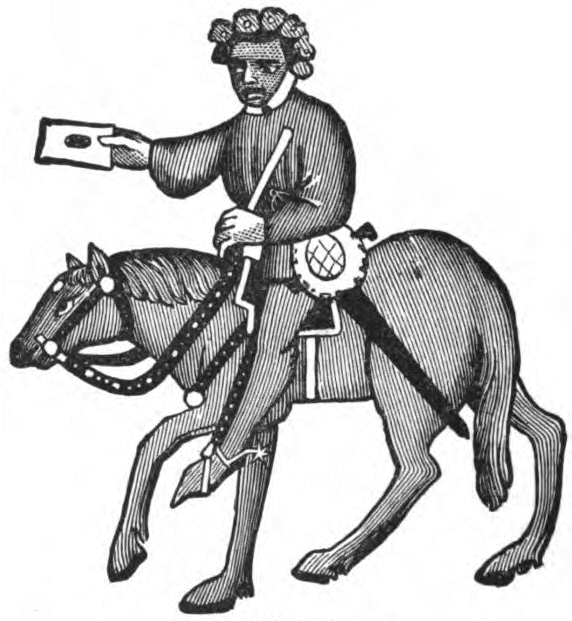

THE SUMMONER
The Summoner or Apparitor was the officer of the ecclesiastical court of the Bishop, or his subordinate, the Archdeacon. This court dealt with sins of immorality, witchcraft, usury, simony, neglect of the sacraments, and withholding tithes or offerings, a list of offences taken from the beginning (n 1299-1320) of the tale about a wicked Summoner which Chaucer puts into the mouth of the Friar. The Archdeacon extorted fines by threats of excommunication, the fact of excommunication, when notified to a civil magistrate, procuring the offenders imprisonment (see below, 1. 662). The Summoners made a living for themselves, over and above their lawful fees, by threatening to report people to the Archdeacon for real or imaginary offences, unless they were bought off. The Ellesmere Ms. shows the Summoner in a blue jacket with scarlet pantaloons, whereas his official costume appears to have been of a tawny colour. He wears a garland and carries a cake as mentioned by Chaucer, and holds out a writ of summons in his hand.
624. a fyr-reed cherubynnes face, a face of a cherub as red as fire. Cherubs being usually depicted in red, 'cherubic' came to mean brilliant. So the author of the Philobiblon speaks of brightly illuminated books as "cherubici libri." The New Eng. Dict. quotes from Thynne's Pride and Lowliness (c. 1570), "A Vintener, His face was redd as any Cherubyn." Cherubin, or rather Cherubim, is a Hebrew plural, but both forms were commonly used as singulars.
646. Questio quid Juris. The question is what [section] of the law applies to this case. [''This kind of question occurs frequently in Ralph de Hengham. After having stated a case, he adds, Quid juris? and then proceeds to give an answer to it." See Heng. Mag. c. xi. "Esto autem quod reus nullo modo venerit ad hunc diem: quid juris?" etc. Tyrwhitt.]
647. a gentil harlot. ‘Harlot' is found used as a masculine early in the 13th century, as a feminine not till the 15th. It seems to have been most frequently applied to travelling jugglers, but is used generally for vagabond, or rascal.
652. a fynch eek koude he pulle, plunder a foolish fellow. Cp. the modern phrase, to ‘pluck a pigeon.' No other use of ‘finch' in this sense is quoted.
658. 'Purs is the Ercedekenes helle,' seyde he. Zupitza would apparently scan 'Purs is | th' Ercedek | enes hel | le sey] de he'—a very ugly rhythm. But Ten Brink quotes this line, and with it 655, as instances of 'the' remaining unelided before a following vowe1. Thus, we may treat both 'helle' and 'seyde' as monosyllables and read 'Purs is] the Ere | edek | enes helle | seyde he.'
661. For ours wol slee,—right as assoillyng savith. Chaucer was no rebel against the religious doctrines of his day, but it is impossible not to believe (what is indicated here by the dash) that he was quite aware that the second half of this line rather diminishes than increases the force of the first. Wyclif openly taught that unrighteous excommunications should be disregarded. Absolution is of no effect unless the penitent is truly contrite. In saying that excommunication is as effective as absolution Chaucer left it open to his readers to think that under certain circumstances neither the one nor the other was of much weight.
662. a Significavit: the writ de excommunicato capiendo, commonly called a Significavit from the beginning of the writ, which is as follows: "Rex Vicecomiti . . . salutem. Significavit nobis venerabilis pater . . . Episcopus," etc. (Tyrwhitt).
The purport of the writ was that the Bishop had signified to the King (i.e. the civil authorities) that a man had remained obstinate after being excommunicated for forty days, and he was therefore forthwith to be put in prison till he made submission.
Ten Brink says that "significavit must be pronounced synficavit" (so Liddell). But no one who understands the genius of English rhythm need find any difficulty in keeping the ordinary pronunciation, making ‘him' a redundant syllable before the caesura: “And al|so war him | of a | Signif|icav|it."
663. In daunger hadde he, etc., under his jurisdiction, in his power to harm. [Cp. Merchant of Venice, IV. i. 180, "You stand within his danger, do you not?" and Tyrwhitt's quotation from a History of the Abbey of Pipwell: ''Nee audebant Abbates eidem resistere, quia aut pro denariis aut pro bladis semper fuerunt abbates in dangerio dicti officialis."]
at his owene gise, to make them follow his own devices.
667. As greet as it were for an ale-stake. A pole projecting from a house, with a garland, or bunch of foliage, on it, was the usual sign of a tavern, whence the proverb, ''good wine needs no bush." [A contemporary picture of an ale-house with its ale-stake will be found in Jusserand's English Wayfaring Life, p. 132. By an Act of Parliament of 1375 it was forbidden to make the poles extend more than seven feet over the public way.]
--o--
These notes are reproduced verbatim from Alfred W. Pollard, Chaucer's Canterbury Tales: The Prologue, London: Macmillan, 1903. The book is in the public domain and available for viewing and download from Google Books. Although the book is old, the notes are enlightening and accurate. Nevertheless, users doing detailed research on aspects of the General Prologue should, if possible, also consult more recent notes in print publications such as The Riverside Chaucer, ed. Larry D. Benson, 3rd ed., Boston: Houghton Mifflin, 1987.